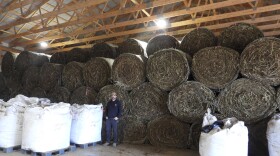With no changes to greenhouse gas emissions, people living across the United States can expect a marked increase in the intensity and frequency of extreme storms. That’s the conclusion of a study released earlier this month from the National Center for Atmospheric Research.
Overall, Kentucky is getting drier. Droughts are becoming a more common occurrence — affecting everything from agriculture to the frequency of forest fires.
But despite the fact that we’re seeing overall less rain, there’s more coming all at once.
“You can already see this in observational records, that the downpours are getting more extreme,” said Andreas Prein.
He’s a scientist at the National Center for Atmospheric Research, and his new study released Monday quantifies how much regions across the country can expect storm intensity and frequency to increase by the end of the century, due to climate change.
There are significant implications for urban areas when lots of rain comes all at once, overflowing sewers, flooding and stormwater runoff. But intense rainfall is also a real problem for Kentucky’s farmers.
Bob Wade, who’s been farming in Sonora, Kentucky since 1987, is one of those farmers.
I was at Wade’s farm last August, when the corn and soybeans he grows were still tall. Both of these crops are really sensitive to rain. Wade needs just enough — not too little, and not too much.
“Especially during the months of July and August, the amounts of rain that we get pretty much determines the yield of the crops that we get,” he said. “We really like rain in the summertime. As long as we don’t get too much.”
By mid-August, there were already a few areas of Wade’s fields that had fallen victim to Kentucky’s summer storms. He pointed to a bare half acre in a corn field.
“The reason that area is bare is because we had a big rain event and it drowned out the corn plants that were there,” he said.
In a nearby soybean field, there’s erosion. A recent heavy storm actually cut a ditch through the field.
Some years, there are droughts. To help protect against losses there, Wade has installed irrigation systems in some areas. But there’s not much he can do to protect the plants against heavy rainfall. And when the intense rain hits the dry soil, he often loses valuable nutrients.
“You can see you have the productive top soil,” Wade said, picking up a handful of dirt. “The color changes about three or four inches down to more of a red. That’s the subsoil. So you really want to protect that top three to four inches of soil. And if that’s washed off, then the yield of your soybean or corn crop is going to be lower.”
And Prein’s research suggests farmers like Wade should brace for more of these complications. In Kentucky, Prein estimates the intensity of storms will increase by 20 percent, so instead of having four inches of rain in an hour, you’ll have five inches. And maybe even more importantly, there will be three times more storms.
“Where you have maybe one extreme thunderstorm a year at the current climate, you may have three in the future,” he said.
This is all under the assumption that carbon dioxide emissions stay the same. These rising emissions have already made the planet warmer over the past century, and Prein said they’re expected to raise temperatures by nine degrees Fahrenheit by the end of this century if nothing changes. This, in turn, will have a direct effect on the frequency and intensity of storms.
“It’s really in our hands if we want to avoid it, or we just keep on continuing emitting greenhouse gases,” he said.





